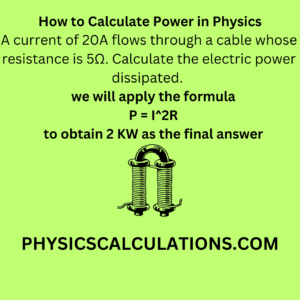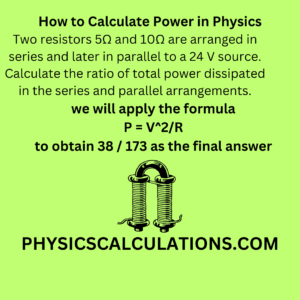Concept of Power
Power is an important concept in physics. It measures the rate of transfer of energy or how work is done. We can define power as the amount of work done or energy transferred per unit of time. The unit of power is watt (W), and the name was an honour to the inventor of the steam engine, James Watt. In physics, power is an important quantity that helps us understand and analyse the behaviour of various physical systems. For example, we can use power to measure:
1. An output of an engine,
2. The rate of heat transfer, or
3. Rate at which an electric circuit consumes or produces energy.
Calculating power involves two key variables: work done or energy transferred, and time taken. The formula for power is P = W/t.
Where:
P is power,
W is the amount of work done or energy transferred, and
t is the time taken.
There are different ways to calculate power depending on the situation. For example, if we know the force applied and the distance moved. We can use the formula P = Fd/t to calculate power. Additionally, if we know the voltage and current in an electric circuit, we can use the formula P = VI to calculate power.
It is essential to understand power and how to calculate it. This is because it helps us to design, analyse, and optimise various physical systems. Whether it’s designing a car engine, analysing the performance of a power plant, or optimising the efficiency of a solar panel. Power plays a critical role in physics and engineering.
What is power?
Definition: Power is simply the rate of doing work. We can also say that power is the ratio of work to the time taken.
The formula for power is
Power = work / time
The unit of power is in watts, kilowatts, Joule per second, or horsepower
Now we can proceed to the definition of electric power
What is Electric Power?
Definition: Electrical power is the quantity of electrical work done or electrical heat transferred per second.
Since we know that
Power = work/time
and work = force x distance
and work done in an electrical material is
W = QV
but Q = It
which implies that
W = IVt
Also, V = IR
Therefore W = I2Rt
From the formula
Power = work / time
we now have
Power = IVt / t
and W = IVt = I2Rt
Power = I2Rt / t
which implies that:
The formula for power in a circuit is Power, P = I2R = IV = V2/R
Where I = current (measured in ampere, A)
R = resistance (measured in ohms, Ω)
V = Potential difference across the conductor (measured in volts)
Q = Quantity of electricity (measured in coloumbs)
W = workdone in transferring heat
P = Power dissipated in watts
Electrical Energy
Definition: Energy is the ability or capacity to do work. In this case, we are dealing with electricity and hence we are going to relate energy with electricity.
Therefore, we have a potential difference across two points which is known as the dissipation of energy by a charge between two points.
Potential difference (p.d), V = Electrical energy that was dissipated (E) / Charge (Q)
Therefore, we now have
V = E / Q
and current (I) is due to the rate of the charge flow. Now we can write Q = It
Which implies that
V = E / It
and we can see that electrical energy is
E = IVt = I2Rt because V = IR
Finding the Cost of Electrical Power Consumption
When electrical equipment consumes one kilowatt of power in one hour, we say that electrical energy of one kilowatt-hour (kWh) is dissipated.
1 kWh = 1 x kW x 1 hr = 1 x 103 x 60 x 60 = 3.6 x 106 Joules
Worked Examples on How to Calculate Power in Physics and Find the Cost of Power Dissipated
Here are examples to acquaint you with the simplest methods of how to calculate power in a circuit. I have also solved examples of how to find the cost of electrical power.
Example 1
A current of 20A flows through a cable whose resistance is 5Ω. Calculate the electric power dissipated. [UTME 2015]
Solution:

Data:
current, I = 20A
Resistance, R = 5Ω
Power, P = ?
by applying the formula for power which is P = I2R
we now have
P = 202 x 5 = 400 x 5 = 2000 watts = 2 kW
Example 2
Two resistors 5Ω and 10Ω are arranged in series and later in parallel to a 24 V source. Calculate the ratio of total power dissipated in the series and parallel arrangements.

Solution:
Data: For the resistance in series, we have
Total resistance, R = 5 + 10 = 15Ω
and Voltage, V = 24V
Therefore, to calculate power for resistance in series, we apply the formula
Pseries = V2/R = 242 / 15 = 576 / 15 = 38.4 Watts
Additionally, we now calculate resistance in parallel
1 / R = (1 / 5) + (1 / 10)
and this implies
1 / R = 0.3
Now we make R subject of the formula
R = 1 / 0.3
Which will give us
R = 3.33Ω
We now calculate power in favour of resistance in parallel
Pparallel = V2/R = 242/3.33 = 576 / 3.33 = 172.97 Watts
The ratio of the power is
Pseriese : Pparallel
Which is
38 : 173
and we have the ratio of the total power dissipated in series and in parallel as 38/173
Example 3
An electric lamp marked 240 volts, 60 Watts is left to operate for an hour. How much energy is generated by the filament?
Solution:
Data:
We need to first extract our data by going through the question again,
Voltage, V = 240 v
Power, P = 60 W
Time, t = 1 hr = 60 x 60 = 3,600 s
and the formula we need to apply to solve the problem is
Power (P) = Energy of the filament (E) / Time (t)
This is the same thing as P = E / T
by making E the subject of the formula, we now have
E = PT
Now we apply our data into the above formula
E = 60 x 3,600 = 216,000 Joules
Therefore, the energy generated by the filament is 216 Kilojoules or 216 kJ
Example 4
A heating coil dissipating energy of 9 x 105 Joules is used to heat water for 30 minutes. Calculate the power supplied to the coil.
Solution
Data
Energy dissipated, E = 9 x 105 Joules
Time, t = 30 minutes = 30 x 60 = 1800 seconds
Applying the formula below
Power (P) = Energy of the filament (E) / Time (t)
This implies that
P = E / t = 9 x 105 / 1800 = 500 Watts
Example 5
An electric bulb is labelled 240V, and the current taken by the bulb is 0.416A. How much power is dissipated by the bulb?
Solution:
Data:
Voltage = 240V
Current, I = 0.416A
Power, P =?
and the formula for power is
P = IV
Now we apply our data to the above expression
P = 240 x 0.416 = 99.84 Watts
And the power can be approximated into
P = 100 Watts
Example 6
If the charge for electricity per kWh is 4 Naira (N4). What is the cost of operating an electrical appliance rated 250V, 2A for 6 hours?
Solution:
Data:
N4 per kWh was given as the cost
Voltage = 250V
Current, I = 2A
Time, t = 6hrs
Thus,
The formula for power consumed is
P = IV = 2 x 250 = 500 watts
Now we change P into kilowatt-hour
P = (500/1000)kW x 6hrs = 0.5kW x 6hrs = 3kWh = 3 units
since the cost per unit or 1kWh is N4, we can now calculate the cost of consumption is
Cost of consumption = N ( 3 x 4) = N12
Example 7
Find the cost of consuming eight 60W bulb, for 8hrs if electric energy costs N5 per unit.
Solution
Data
Power, P = 8 bulbs x 60W = 480W = 0.48kW
Time, t = 8hrs
Energy,E = Power (P) x Time (t) = 0.48kWh x 8hrs = 3.84 kWh
E = 3.84 units
The cost of consumption is
N(3.84 x 5) = N19.2
Thus the cost of consumption is 19.2 Naira.
Example 8
A 200W bulb is lighted by a 240V a.c main supply. If 1kWh is sold at N40, what is the cost of keeping the bulb lighted for one day.
Solution:
Data:
We find our data by reading the question again
Power, P = 200W = 0.2kW
Voltage, V = 240V
Time, t = 24hrs
We apply the formula
Cost of consumption will be = Power x time x cost
This will be Cost = 0.2kW x 24hrs x N40 = N192
Therefore, the cost of consumption is N192
Example 9
An electric bulb is rated 60W for a 240v supply. Calculate the resistance of the bulb and the current it consumes.
Solutions
Data
Power, P = 60W
Voltage, V = 240v
Resistance = ?
current, I = ?
The formula is
P = V2 / R
R = (240)2 / 60
R = 57,600 / 60 = 960Ω
and the current (I)
I = P / R
which implies that
I = 240 / 960 = 0.25A
Thus, the current is 0.25A
Example 10
A lamp is marked 220V, 60W. Calculate the energy it would consume when connected to a 220V source for 1 hour.
Solution
Data:
Voltage = 220V
Power = 60W
Time, t = 1 hour = 60 x 60 = 3600 seconds
Energy = Power x Time = 60 x 3600 = 216,000 Joule = 216 kJ
You can check our questions and answers page to see more questions on how to calculate power in physics.
You may also like to read:
How to Calculate Capacitive Reactance
Reference: